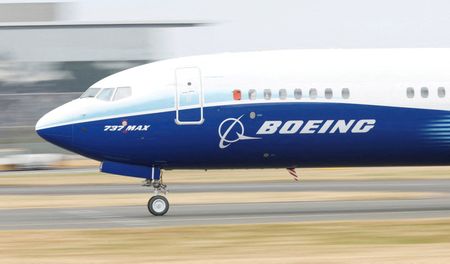By Tim Hepher, David Shepardson and Rajesh Kumar Singh
(Reuters) – Boeing has embarked on a high-risk waiting game over the next round of jet developments, betting nascent technology will restore it to glory in the 2030s while ceding the upper hand in a key part of the market to Airbus for the rest of this decade.
Chief Executive Dave Calhoun on Wednesday buried the prospect of an early bid to rebuild Boeing’s battered position at the top of the single-aisle market with a new jet, pledging to focus on cash as it recovers from safety and other crises.
The move marks a victory for engine-maker CFM which had publicly trailed a radical design offering 20%-plus fuel savings but not before 2035 – effectively nudging its biggest customer away from acting any sooner with a more conventional plane.
Industry sources said lifting the spectre of a new jet also cheered Airbus which – like CFM – has most to gain from milking a favourable status quo and avoiding a premature product race.
Between them, billions of dollars in potential R&D savings are at stake.
CFM, co-owned by General Electric and Safran, powers Boeing 737 MAXs and about half the Airbus A320/321neo family, which has a strong market lead.
That doesn’t bother Calhoun who played down runaway sales of the A321neo.
“I don’t want to fill a gap in a product line. I want to build a product that’s going to differentiate in a way that absolutely substitutes the airplanes that came before it,” Calhoun told analysts at an investor day.
Such a plane would be 20-30% more efficient and start to lay the groundwork for future autonomous or machine-driven flight.
“There’ll be a moment in time where we’ll pull the rabbit out of the hat and introduce a new airplane sometime in the middle of the next decade,” he said.
Analysts said that was meant to reassure investors Boeing would not embark on a $15-billion spree before reducing its $45 billion of net debt, while reassuring restless airlines any 737 successor would be worth the wait.
That marks what some industry sources described as a quiet but decisive U-turn behind the scenes after months in which the planemaker had been informally touting the possibility of a pair of late 2020s jets known as 5X and 6X to block the A321neo.
It now calculates the MAX family of aircraft will carry it through the decade, as originally planned, in the face of still-evolving technology and limited resources.
Investors mostly agreed, pushing up Boeing’s shares some 10%.
MARKET SHARE
But industry insiders said there were a number of risks in Calhoun’s strategy of waiting out the 2020s.
First, Boeing is now more than ever dependent on getting its MAX 10 – needed to counter the A321neo – certified.
That depends on a Congressional waiver which although far from automatic is ultimately likely to happen, congressional aides say. If it fails, the 5X/6X may yet see the light of day.
Second, it leaves Airbus with an entrenched market lead through the decade, rather than the 50/50 split seen over time.
That offers Airbus a cost advantage as well as a useful negotiating currency with which to convert existing customers to its own next jet likely to appear in the 2030s.
Calhoun stressed market share was not the issue.
But industry experts said it appeared no accident that Boeing’s mid-decade delivery forecasts – 50 single-aisles a month compared with Airbus’ goal of 75 – gave Boeing an implied share of 40%, widely seen as the lowest needed for a duopoly to remain stable.
“They are settling for 40% but no less,” a senior industry source said.
Neither planemaker was immediately available for comment.
Sitting out the decade also leaves the MAX family exposed to competition from a potential new variant of Airbus’ smaller but lighter A220. Airbus has said the A220-500 is “when not if”.
Amid the threat to its MAX cash cow from below, Boeing highlighted plans to put pressure on Airbus from above and generate more cash by pledging higher 787 wide-body output.
Harder to measure are the intangible risks of waiting.
Ron Epstein of Bank of America said lack of investment historically turns market dominance to “market subordination”.
Calhoun insists patience will pay off next decade. Until then, the numbers of a lop-sided duopoly favour Airbus barring a setback in its own output plans, which many see as ambitious.
“If we bring any of the capabilities that I am suggesting will be available to us at that moment…leadership will be well within our grasp,” Calhoun said.
(Writing by Tim Hepher. Editing by Jane Merriman)

